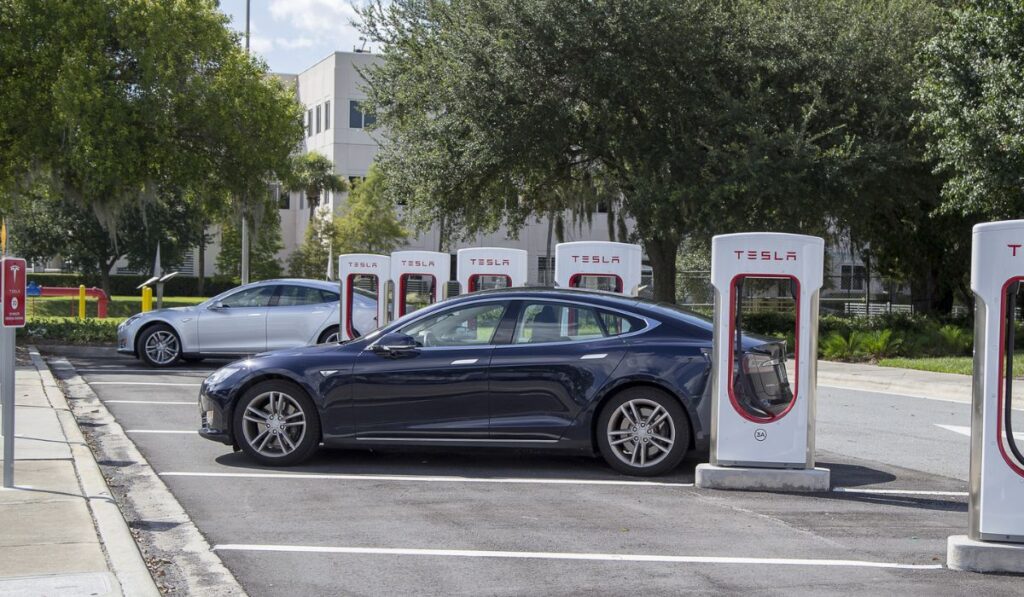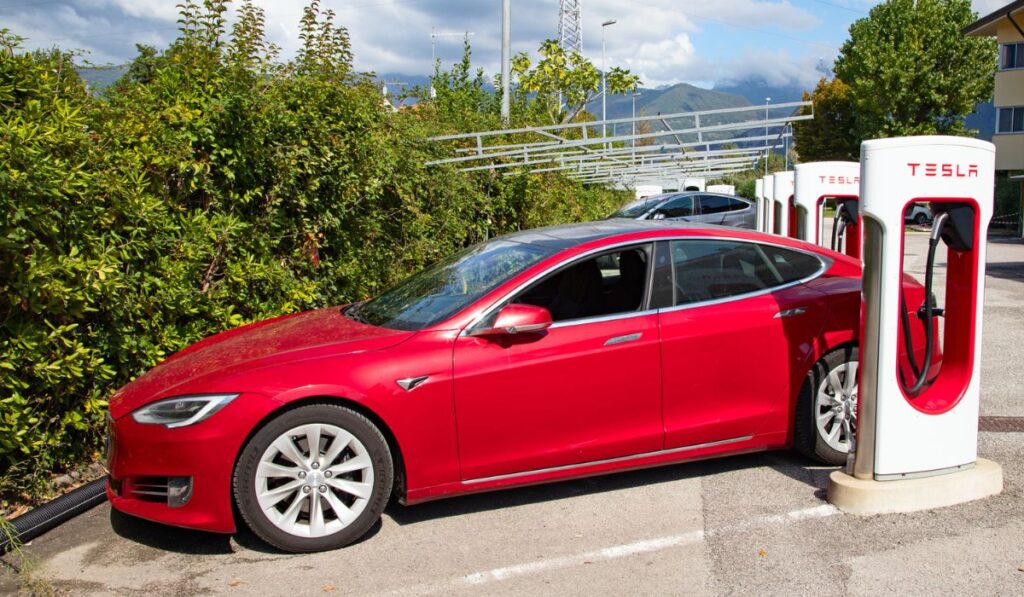When it comes to owning an electric vehicle, most people consider Tesla to be the leader in this field. Their vehicles are praised for not only being efficient but also cost-effective. But one concern about owning a Tesla is how far it can go on a full charge.
The distance a Tesla can travel on a full charge varies based on several factors, like its model (which affects the battery’s size), weather conditions, and your driving habits. Estimated ranges start at 267 miles for the most basic model and tap out at about 400 miles in a premium model.
Before planning a long-distance trip, it’s important to make sure you know how far you can go on a single charge. Let’s take a look at the major factors that affect the maximum distance, and how to manage recharging your Tesla.
Can Teslas Go Long Distance?

The distance you can go when you are driving a Tesla depends entirely on the model you choose to purchase. In addition, several other factors can affect the range a Tesla can go on a single charge.
Depending on the model of Tesla you choose, it can travel a variety of distances on a single charge. The typical range is between about 267 and 400 miles. This means that, yes, a Tesla can go long distances.
It’s important to keep in mind that while you can drive that far with a single charge, you’ll find charging stations in cities around the world. This means that if your vehicle needs to be charged, you can do so along the way.
Because the mileage range can vary depending on the model, it’s worth it to learn more about the available options. Here’s a breakdown of the distances that different Tesla models can travel on a single charge.
Model 3
Tesla Model 3 cars include three different models as a part of the series and are considered the most affordable of all Tesla models. Each of the three have a different mileage range and set of features.
The Model 3 Standard Range, which is the least expensive of the models, needs to be recharged after significantly fewer miles than all other models. You can expect a maximum of about 267 miles on a single charge.
The Model 3 Long Range, which is more expensive, can go the longest of this series of Teslas. You won’t have to worry about charging this model for about 334 miles down the road.
The Model 3 Performance vehicle is the most expensive of the series and is made to withstand higher speeds. The mileage range on this model, however, is only about 315 miles before you have to recharge it.
Model S
This model of the Tesla comes in two different types and also varies significantly from each other in style, performance, and mileage range. While these models are very similar in body style, there are significant differences between them.
The Model S is considered to be the flagship model for the company. It lasts between 375 to 400 miles before needing a recharge.
The Model S Plaid is a bit more expensive than the Model S, but comes equipped with more horsepower to provide a better overall performance. Due to its power and weight, this model can travel between 348 to 396 miles before needing to be recharged.
Model X
In addition to the car models, Tesla also offers two SUV series of electric vehicles for those who prefer more room. While the SUV models may be more comfortable, they need to be recharged more often.
The Model X is considered to be a mid-sized SUV crossover that can provide you with ample room to have friends and family along. Typically, it can travel between 332 to 351 miles before you have to find a charging station.
The Model X Plaid, like the S series Plaid, is a more expensive model. It’s much like the Model X but with additional horsepower. You can travel about 313 to 333 miles before recharging.
Model Y
The Model Y are also SUVs designed to provide more room. This is the newest model of the Tesla line and is significantly less expensive than the Model X SUV models.
The Model Y Long Range is the less expensive of the two in the series and offers more basic features. It can run for about 318 miles before you will need to find a charging station.
The Model Y Performance is exactly what it sounds like. It’s equipped with extra features that make it perform much better than the standard models. This model can travel between 280 and 303 miles before needing to be recharged.
What Factors Affect How Far a Tesla Can Go?
When determining the range of your new Tesla vehicle, there’s multiple factors to consider. While the company provides mileage ranges, they’re only estimates.
Because of this, it is important to understand that your Tesla may vary from others because of the environment and your personal driving habits.
Tesla Model
A Tesla’s model is the best way to determine the estimated mileage before you have to recharge.
The size of the battery plays a role in the distance you can travel before recharging. For example, the Model 3 is the most affordable model of the Tesla because it has a smaller battery. However, this means that you’ll have to recharge more often in comparison with other models.
In general, the S series is the model of the Tesla can go the longest without having to be recharged. It provides more performance ability and is designed for the open road.
Driving Habits
Another and equally important factor that determines the Tesla mileage range is the driver’s habits.
How you handle your Tesla has a direct impact on the distance it can go before you’ll need to find a charging station. Under certain circumstances, your battery has to work harder to keep up with what you’re doing.
For those that consistently drive faster than recommended, the battery will have to work harder to keep up, which can affect the miles you can travel on a single charge. If you are a stop-and-go driver, this can result in the battery depleting more quickly than you would expect.
Driving habits also include how often you drive on an incline. Going uphill often can deplete your battery faster than if you were driving straight or even downhill.
Charging Habits
The way you charge your battery can also determine the distance you can go on a single full charge. This is because if you take short trips here and there and do not charge your car’s battery regularly, the life of the battery will deplete faster.
Tesla recommends that you charge your battery every day as long as you are using a low-voltage charger. This will condition your battery to work more efficiently and use its full capacity every time.
It’s also best to not allow the battery to get too low too often if you can avoid it. This can reduce your battery’s overall capacity. Using fast charging stations frequently can also deplete your battery’s capacity.
It is important to keep in mind that every Tesla battery comes equipped with a charge limit that should be adhered to at all times. This means that you should only charge your battery to the limit stated by the manufacturer for the best results.
Weather Conditions
That said, there are some factors are beyond your control. As with most vehicles, weather conditions can affect the performance of the inner workings of a car’s motor. This is no different with Teslas and other electric vehicles, because they function based on the battery’s life.
During conditions like rain, sleet, snow, and strong winds, your Tesla’s battery is having to work overtime to keep up. While driving in these conditions may be unavoidable, there’s sometimes things you can do to prolong the battery’s life.
Taking certain precautions can help you to avoid running your battery down more quickly during inclement weather. One of these is ensuring that your Tesla is plugged in during colder weather to keep it in a warmer state.
Tesla manufacturers also recommend preconditioning your vehicle before starting it up right away. For example, if it’s not already plugged in, plug it in to let the battery warm up before starting it.
Additionally, it is important to note that the Tesla has heaters in the seat that should be used over the heater for the car itself. This is because it uses less energy and does a great job of heating the entire inside of the vehicle.
What Happens When a Tesla Runs Out of Charge?
Most people know the intense frustration that running out of gas in a standard vehicle can cause, especially if you need to be somewhere quickly. The same can happen with an electric car if you overestimate the distance you can travel on a single charge.
Just like with a standard vehicle that uses gas, a Tesla cannot go any further if the battery dies. Should this happen, you have only three options available: calling roadside assistance, contacting a towing company, or using a mobile charger, if you have one.
Calling roadside assistance can help in some cases better than just calling for a tow, as they can assess the situation beforehand. Occasionally, a portable charger can be brought to you.
But while roadside assistance may be your best option, unless you have a mobile charger, sometimes calling a towing company may be faster. This will depend entirely on how much time you have to spend.
Investing in a mobile charger can help you during this type of situation, allowing you enough juice to get to a charging station. Even though this seems like the simplest solution, mobile chargers can be quite expensive.
How Much Does It Cost to Charge a Tesla at a Charging Station?

Charging your Tesla at a charging station is the only way to make your long-distance trips work in the long run. Because the capacity of the battery on any model of Tesla is less than 400 miles, driving further will possibly require you to stop at a charging station more than once.
Most charging stations will vary in cost depending on the average cost of electricity in the area. For example, to charge a Tesla on a supercharge station, it will cost an average of about $0.25 per kilowatt, which roughly translates to about $22 total.
Keep in mind that while that is the average cost, it’s very much dependent on your location. Additionally, if you are not charging at a supercharger, it may be significantly less to charge it.
The bottom line is that the distance a Tesla can travel on a single charge depends on several factors, including the model you have, driving habits, and weather conditions. Regardless, be sure to be aware of the locations of charging stations when planning a long-distance trip.

zelma
Saturday 7th of January 2023
Waiting patiently for you to come home and fuck me! https://bit.ly/3UKFVxa
zelma
Thursday 29th of December 2022
Waiting patiently for you to come home and fuck me! https://bit.ly/3UKFVxa
zelma
Tuesday 13th of December 2022
Waiting patiently for you to come home and fuck me! https://bit.ly/3UKFVxa
zelma
Monday 28th of November 2022
Waiting patiently for you to come home and fuck me! https://bit.ly/3UIKI2R
zelma
Tuesday 22nd of November 2022
Waiting patiently for you to come home and fuck me! https://bit.ly/3UIKI2R